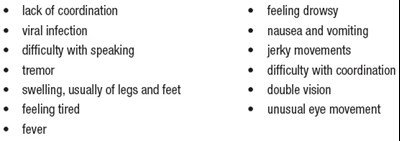Product Images Gabapentin
View Photos of Packaging, Labels & Appearance
Product Label Images
The following 14 images provide visual information about the product associated with Gabapentin NDC 50090-6189 by A-s Medication Solutions, such as packaging, labeling, and the appearance of the drug itself. This resource could be helpful for medical professionals, pharmacists, and patients seeking to verify medication information and ensure they have the correct product.
sideeffects - Sideeffects

This text describes symptoms that may be experienced by a person suffering from a neurological disorder or viral infection. These symptoms include difficulty with speaking and coordinating actions, tremors, fatigue, fever, drowsiness, and swelling in the legs and feet. Additionally, the person may experience jerky movements, double vision, nausea, vomiting, and unusual eye movements. These symptoms may impact a person's ability to carry out day-to-day activities and warrant a visit to a healthcare professional.*
Table-1 - Table1

This is a dosage table for Gabapentin based on renal function. The Total Daily Dose of Gabapentin for patients is given based on their Creatinine Clearance rate in mL/min, and the recommended dosage regimen for the same is given in mg/day. The dosage is given based on different ranges of Creatinine Clearance rate in mL/min of the patient. Additionally, it provides supplemental doses for patients on post-hemodialysis treatment. The dosage must be adjusted for patients with Creatinine Clearance <15 mL/min. The table also explains the abbreviations used for the dosage regimens (TID, BID, QD).*
Table-2 - Table2

This looks like a table presenting a risk analysis for antiepileptic drugs in patients with epilepsy and other psychiatric conditions. The table shows the rates of events per 1,000 patients in placebo and drug-treated groups, as well as the relative risk and risk difference. Unfortunately, without further context or specific information about the events, it is difficult to provide a more detailed description.*
Table-3 - Table3

This is a table showing adverse reactions reported in pooled placebo-controlled trials for the use of Gabapentin in the treatment of postherpetic neuralgia. Adverse reactions are listed by body system or area affected, with the percentage of patients who experienced the adverse reaction shown for each treatment group. Adverse reactions in the Gabapentin group were higher compared to the placebo group. Adverse reactions for the Gabapentin group included Dizziness, somnolence, Peripheral edema, Diarrhea, Dry mouth, Weight gain, and Abnormal thinking. Blurred vision was reported under the "Special Senses" category with a percentage of 3 in the Gabapentin group and 1 in the Placebo group.*
Table-4 - Table4

This is a table that shows the adverse reactions in pooled placebo-controlled add-on trials in epilepsy patients aged 12 years and older who were treated with Gabapentin. The table compares the percentage of patients who experienced adverse reactions in the Gabapentin group (N=543) and the placebo group (N=378). Adverse reactions noted in the body as a whole, cardiovascular, digestive, nervous, respiratory, skin and sensory systems are mentioned. Some of the most common reactions observed in the Gabapentin group were fatigue, somnolence, and dizziness. The note on the table explains that amblyopia, which is a visual impairment, was often described as blurred vision.*
Table-5 - Table5

The table presents adverse reactions observed in a placebo-controlled add-on trial involving pediatric epilepsy patients aged 3 to 12 years who were administered Gabapentin®. The table compares the incidence of adverse reactions between the Gabapentin® group (N=119) and the placebo group (N=128). The adverse reactions observed were nausea and/or vomiting, emotional lability, respiratory infections, and phosphorous and bromine metabolism associated with the epilepsy drug.*
Table-6 - Table6

This is a table showing information about two controlled studies for a medication called Gabapentin that was used to treat PHN (Postherpetic Neuralgia). The table lists the duration of the studies, dosages given, and the number of patients who received Gabapentin or a placebo. Study 1 lasted for 8 weeks, with a target Gabapentin dose of 3600 mg/day. The study had 113 patients receiving Gabapentin and 116 patients receiving a placebo. Study 2 lasted for 7 weeks, with Gabapentin given at doses of 1800 and 2400 mg/day, divided into three doses per day. The study had 223 patients receiving Gabapentin and 111 patients receiving a placebo. In total, there were 336 patients who received Gabapentin and 221 patients who received a placebo across both studies.*
Figure-1 - figure1

The figure shows the weekly mean pain scores observed in Study 1's ITT population. The X-axis depicts baseline and the weeks 1,2,3,4,5,& 8 while the Y-axis shows the pain score. A-Gabapentin with 3500 iy is used as the treatment.*
Figure-3 - figure3

The text provided refers to Figure 3 of a study related to controlled PHN studies. The figure shows the proportion of responders (patients with > 50% reduction in pain score) at Endpoint, represented as a graph where the x-axis shows different studies, and the y-axis shows the percentage of patients with pain reduction. However, it is not clear what the units of the reduction in pain score are, or what GBP or PBO mean.*
* The product label images have been analyzed using a combination of traditional computing and machine learning techniques. It should be noted that the descriptions provided may not be entirely accurate as they are experimental in nature. Use the information in this page at your own discretion and risk.




